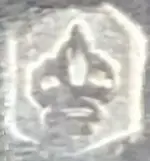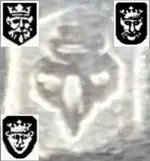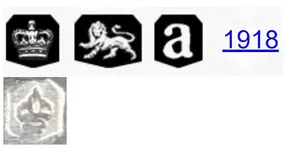Hmmm... ?
This is the "Lion Passant" mark.... denoting STERLING.
This IS an English / England based mark.
When in doubt... TEST IT> !
Sorry, but It’s not correct to say that the lion passant mark DENOTES sterling in the sense that it proves the piece must be English silver. The whole point of a pseudo-hallmark is to imitate the real thing sufficiently well to mislead or deceive an unwary purchaser.
Let’s just rephrase that to “the lion passant is the official symbol for Sterling silver produced in England and authenticates the piece if it has been applied by an English Assay Office together with the other statutory marks required by law, and the full set of marks is consistent in design and form with those stipulated at the time.” It's a serious offence to apply the mark in other circumstances.
What that means is that the mark can be, and has been, used by others (especially in countries outside the reaches of English justice, and notably in America and the Far East) to misrepresent a piece for the purposes of enhancing its perceived value. Usually these fake or pseudo-marks have sufficient stylistic differences to negate accusations of outright fraud but, again, manufacturers outside England have been prepared to push the boundaries of ‘similarity’ somewhat further than those within it.
One notable difference between highly regulated English hallmarks and (say) poorly regulated/policed American marks is that they were actually applied by the Assay Office itself, not by the maker. The degree of standardisation is therefore very high and deviations from that standard on English pieces are to be regarded with extreme suspicion. In most cases, the deviations seen on pseudo hallmarks are sufficiently abnormal that they can readily be said not to be authentic… except by unwary buyers.
Just what, exactly, are you supposing this to be as a town/city mark?

There have only been seven English Assay Offices using the lion passant: Birmingham, Chester, Exeter, London, Newcastle, Sheffield, and York; but none of them used a mark like that.
Birmingham
That style of ‘a’ as a date letter could be for 1798 (in which case there would also be a King’s head duty mark, which isn’t present) or 1900. However, the city mark would be an anchor whatever the date, and it’s not there.
Chester
That style of ‘a’ as a date letter could be for 1751 or 1756 but would be accompanied by the city mark as a sword with wheatsheaves and a crowned leopard’s head, facing. Neither of those are present.
Exeter
That style of ‘a’ as a date letter could be for 1817 but would be accompanied by a King’s head duty mark. It’s not present and, in any case, the city mark would be a castle which is also not present.
London
That style of ‘a’ as a date letter could be for 1736, 1776 or 1816 (the latter should have the King’s head duty mark, which is not present). The city mark should be crowned leopard’s head, facing. I suppose if you turn the first mark upside down and squint a bit, you might imagine a passing resemblance to a leopard’s head but no… that’s not a London mark. The cartouche shape is also wrong.
 Newcastle
Newcastle
That style of ‘a’ as a date letter could be for 1864 but it would be in an oval cartouche and the Queen’s head duty mark would also be present, but it’s not there. The Newcastle mark should also have the leopard’s head, facing alongside the lion passant and the city mark would be three towers. Wrong on all counts.
Sheffield
That style of ‘a’ as a date letter could be for 1824 (in which case there would also be a King’s head duty mark, which is not present) or 1918. The latter is perhaps the closest resemblance, but there are significant differences from an authentic English hallmark and the city mark would be a recognisable Tudor crown. The first mark is somewhat crown-like in appearance, but It’s not a Sheffield mark.
 York
York
That style of ‘a’ was never used as a date letter and, in any case, although York used several different city marks, none them look anything like the mark on this piece.
Those are the only possibilities for an English Sterling mark. None of them stack up.















